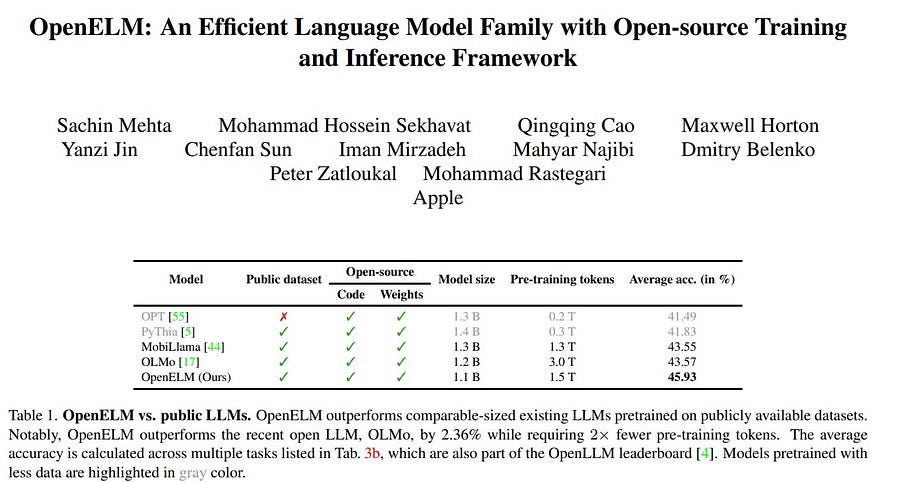- Weekly AI News
- Posts
- Apple OpenELM: On-Device AI
Apple OpenELM: On-Device AI
OpenELM vs. public LLMs & more
Apple recently unveiled its OpenELM (Open-source Efficient Language Models) initiative, marking a significant shift in its approach to artificial intelligence (AI).
Unlike traditional models that rely on cloud computing, OpenELM’s suite of models is designed to run directly on devices.
This development is not only a testament to Apple’s innovative edge but also underscores its commitment to enhancing user privacy and device efficiency.

Screenshot by Author
What is OpenELM?
OpenELM consists of a family of eight large language models, with parameters ranging from 270 million to 3 billion.
These models are engineered to optimize both the efficiency and accuracy of AI functionalities on consumer devices, using a pioneering layer-wise scaling strategy.
This technique ensures an optimal distribution of parameters across the transformer model layers, leading to a significant improvement in performance.
Notably, OpenELM models demonstrate a 2.36% increase in accuracy over other models with similar configurations.
OpenELM’s Open-Source Nature
In a departure from its traditionally secretive operations, Apple has made OpenELM open source.
This move facilitates a collaborative environment, allowing developers and researchers worldwide to contribute to and expand upon Apple’s initial groundwork.
The open-source nature of OpenELM not only democratizes access to cutting-edge technology but also opens up new possibilities for tackling biases and risks inherent in AI development.

Screenshot by Author
OpenELM vs. OpenAI
While OpenELM and OpenAI both contribute to the field of AI and language model development, they are distinct entities with different goals and methodologies.
OpenELM, developed by Apple, emphasizes efficient, on-device AI that enhances user privacy by eliminating the need for cloud processing.
On the other hand, OpenAI, known for its GPT series, focuses on large-scale cloud-based models that have powered a wide range of applications but with different privacy considerations.
Apple’s approach with OpenELM is particularly notable for its focus on privacy and local processing, contrasting with OpenAI’s model, which often requires significant computational resources and data processing capabilities that can only be handled in cloud environments.
OpenELM’s open-source strategy also marks a stark contrast to OpenAI’s more controlled release of technology, balancing proprietary developments with open-source contributions.
OpenELM vs. public LLMs
User Privacy and Device Capability
One of the most compelling aspects of OpenELM is its ability to process data directly on the device, thus bypassing the need for cloud computing. This method significantly enhances user privacy by keeping sensitive data localized and secure. Furthermore, with the anticipated integration of OpenELM into iOS 18, users can expect faster and more responsive AI-driven features, potentially revolutionizing how we interact with devices like iPhones and iPads.
Future Directions and iOS 18
While the current models have not yet been integrated into Apple’s product ecosystem, rumors about iOS 18 suggest an exciting future.
The new update is expected to leverage OpenELM’s capabilities for advanced on-device AI functionalities, possibly offering enhanced versions of Siri and other applications that utilize AI more deeply and efficiently.
What’s ahead?
Apple’s OpenELM represents a groundbreaking step forward in on-device AI capabilities.
By providing powerful AI functionalities directly on user devices, Apple is not only setting new standards in the tech industry but also prioritizing user privacy and device performance.
The release of OpenELM through the Hugging Face Hub ensures that the broader research community can partake in this innovative journey, potentially leading to more personalized and secure AI applications in everyday technology.
There’s more to come…
As we await the full integration of OpenELM in iOS 18 and beyond, the possibilities for what on-device AI can achieve are boundless.
Apple’s forward-thinking approach may well redefine our expectations of smart devices, making them not only tools of convenience but also guardians of our digital privacy.
If you want more updates related to AI, subscribe to our Newsletter

Reply